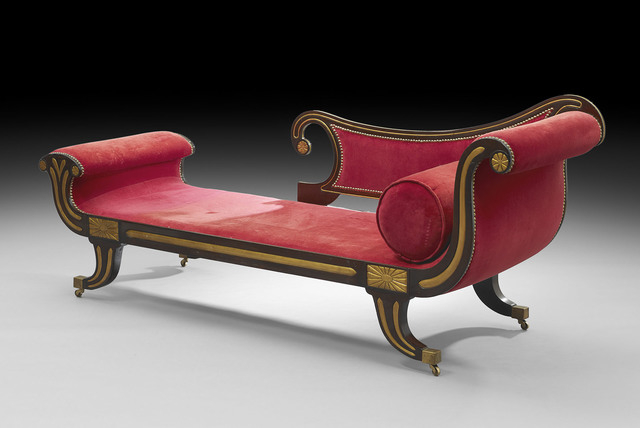Tracing the roots of furniture names
Furniture often has unexpected names that honor the maker or a connection to a famous person. A Chippendale or Sheraton chair is named for the designer. Larkin desks are named for the company that gave them away. The Wooten desk was named for the maker, Mr. Wooten. But the Recamier sofa is named for the woman who posed for a portrait on the lopsided bench.
For many centuries there had been armless benches and window seats — small benches with arms at each end that did not block the view from the window. By the 1800s, there were long chairs with the French name “chaise longue,” made so your feet were kept as high as the chair seat. But by 1800, the seats included the “meridienne,” a bench with arms but no back made for lounging, not sitting.
Madame Juliette Recamier had her portrait painted while stretched out on one of these. The portrait, by Jacques-Louis David, became so famous the Directoire piece of furniture was called a Recamier by the public and the name stuck. The end of the story is strange.
When the portrait was almost finished, she hired another artist to do another portrait. David was so angry he never finished his picture. Part of the canvas shows in the background — her head was missing details and the artist did not glaze the painting. It was given to the Louvre Museum in Paris in 1826 and because it is unfinished, it has been a guide to the methods and brushwork used by the artist.
Recamier sofas have remained in fashion. A Regency-style, mid-19th-century example was offered at a New Orleans auction in the summer of 2014 with an estimate of $2,000 to $4,000. Like many of these pieces, it has a cylindrical pillow tucked at the base of the scroll arm. But it also has a partially curved back.
Q: I have a heavy metal sign that reads “Railway Express Agency.” It’s a diamond shape, 8 inches on each side and 11 inches across the middle. I’m wondering if this was a forerunner of UPS or FedEx companies. Does it have any value?
A: In 1918, during World War I, the U.S. government took over the railroads and combined several express carriers to form the American Railway Express Co. in order to ensure safe delivery of material during the war. The railroads were returned to their owners in 1920, after the war ended.
In 1929, the assets of The American Railway Express Co. were acquired by The Railway Express Agency, a company formed by 86 U.S. railroads. In 1970 it became REA Express, Inc. The company went bankrupt in 1975.
There is no connection between the Railway Express Agency, UPS and FexEx. Railway Express signs were made in several sizes and have been reproduced. A sign the size of yours sold for $27 online.
Q: My grandmother left me a cookie jar shaped like a barn. It’s brown with some details in yellow. The farmer’s wife is standing in the door to the barn, hands on hips, and the farmer is in the background. It says “Dutch Treat” in yellow across the front of the barn. There are no markings on it. Who made it and what is it worth?
A: This Dutch Treat cookie jar is said to have been made by McCoy between 1968 and 1973, even though there is no mark. It sells for about $50.
Q: I inherited a mid-19th-century melodeon about 50 years ago. The woman who had it knew nothing about it. The cabinet is in pristine condition and the instrument itself is in perfect working condition. It’s marked “B. Shoninger, New Haven, Conn.” How old is it and what is it worth?
A: Bernard Shoninger founded B. Shoninger &Co. in 1850. The company made melodeons, pianos and organs. The melodeon was invented by Jeramiah Carhart in 1835. He wanted to make an instrument with a softer sound than a reed organ.
His sons took over the business in 1898 and only pianos were made after that. The company went out of business in 1929 but Shoninger pianos continued to be made by National Piano Corp. of New York until the 1960s. Melodeons are hard to sell because few people play them. Prices are in the low hundreds of dollars.
Q: I have a sugar container with ornate ear-like handles and no lid. I think it’s pewter. It’s marked with a circle and the words “Meriden B. Company” surrounding a shield with a balance scale inside it. It’s dated 1836. Can you give me the history and value?
A: Your sugar container was made by Meriden Britannia Co. of Meriden, Conn. It was founded in 1852 and became part of International Silver Co. in 1898. The number on your sugar is not the date, the company was not in business that early, it’s the catalog number.
Your sugar is silver plate, not pewter, and was pictured in Meriden’s 1886-’87 as part of a tete-a-tete set that included coffeepot, teapot, sugar and creamer with catalog numbers 1836 and 1837. A set of four pieces was originally $14.50. Value of your sugar today is about $25.
Q: I am giving my grandfather’s antique brass barometer (circa 1930) to my sister for her birthday. Should I polish it, or does that detract from the value?
A: Don’t polish it. If it needs to be polished, you should have a professional restorer do the job. Someone who repairs clocks might be able to polish it.
Tip: The best place to store paintings is in a closet with no exterior walls. The temperature and humidity levels will be the best in your house.
Terry &Kim Kovel’s column is syndicated by King Features. Write to: Kovels, (Las Vegas Review-Journal), King Features Syndicate, 300 W. 57th St., New York, NY 10019.

















